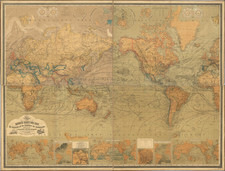Search
Giles Land was first recorded by a whaler commanded by Cornelis Giles in 1707. The mysterious land in the Arctic was not reliably seen again for a century and a half. It ranged on maps east and northeast of Svalbard and eventually settled roughly 160 kilometers north of Kvitøya, which is in the east of the Svalbard Archipelago. Today, it is accepted that Giles Land as sighted in 1707 was likely Kvitøya itself, re-discovered and named by Johan Kjeldsen in 1876.
Giles’ sighting of a white-capped island quickly made its way onto maps, although Giles’ own description of the island is now lost (although a record of it from 1775 does survive). Gerard van Keulen included Commandeur Giles Land on a map of Svalbard in 1714. Other maps would call the island Giles, Gillies, Gilies, and Gillis. By the end of the eighteenth century, most maps showed the landmass in approximately the position of Kvitøya today, following van Keulen.
During his 1863-4 expedition to the area, Adolf Erik Nordenskiöld saw a large island at 79°N 26°E; he assumed it was Giles Land, although it was not in the position described by Van Keulen. However, it was likely Svenskøya, the westernmost island in the Kong Karls Land islands. Nordenskiöld was actually the most prominent in a string of land sightings that shifted Giles Land to the east and southeast of previous understandings. Baur, on his revision of Bromme’s map, showed the most extreme interpretation of Giles Land, portraying it as a massive, unfinished coastline just east of Svalbard and as large as the rest of the archipelago combined.
Most influential in the fixing of Giles Land was August Heinrich Petermann. In his Arctic maps of the 1870s he showed Giles Land at 81°30’N 36°E, far removed from where Giles had reported his sighting. This placed it farther to the north and east than van Keulen’s depiction.
Despite the fact that Petermann explained that this placement was only conjecture, other mapmakers quickly took up his placement of the island. Therefore, even when Kvitøya was located and named in 1876, many mapmakers retained Giles Land father north. A. M Brice wrote of the island in 1896, “It is true that you will find it in your maps to-day a degree and a half further north, but that seems to be mainly due to the waywardness of a German geographer and the complaisance of those English cartographers who believe in maps made in Germany.”
Frederick Jackson looked in the area described by Petermann in August 1897, during the Jackson-Harmsworth expedition to Franz Josef Land. He was turned back by ice but sighted no land and sounded deep water. Also in summer 1897, Salomon August Andrée passed over the ice in the area after a failed balloon journey toward the North Pole. He had consulted Bartholomew’s updated map of 1897, which included Giles Land in the Petermann location. However, he too found no island. Andrée and his companions tragically perished on Kvitøya, leaving their findings unknown for decades.
The island lived on, for example in the corrected Admiralty chart of the Barents and Greenland seas of 1908. However, the ice had largely kept ships away from Petermann’s coordinates, making absolute verification impossible. Frank Worsley, who had been with Shackleton on the Endurance expedition (1914-1917) searched for it (seeking both a Gilles Land and a Gillis Land) in 1925.
Andrée’s papers were found in 1930, which helped to clarify that Giles Land was certainly not where Petermann had placed it. Consensus began to cohere around Kvitøya being Giles Land, although a Soviet expedition in 1935 still looked for Gillis Land (at the Petermann coordinates and now thought to be a different island than Giles or Gilles Land near Svalbard). They again found no land and the mystery of Giles Land was finally laid to rest, although it remains an instructive lesson in how a geographic hypothesis can become an accepted feature on maps.

